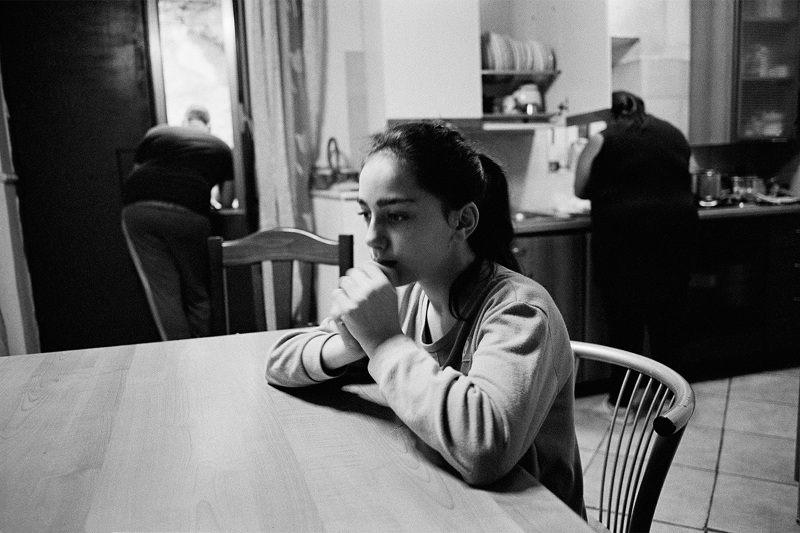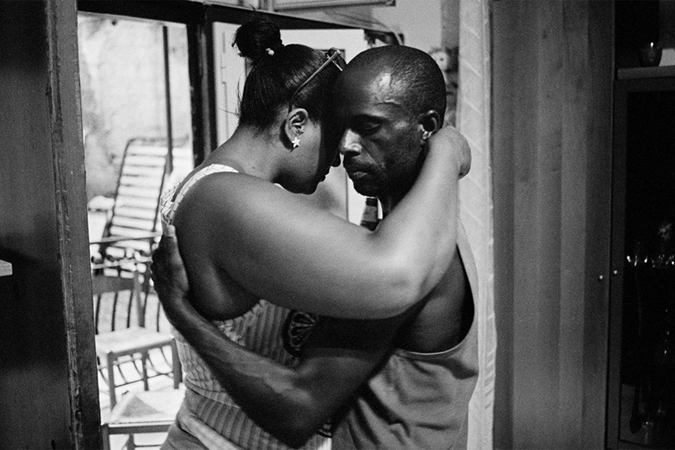Critics have long remarked on the difficulty of reviewing a book immediately after its publication. Ciro Battiloro’s stunning debut, Silence Is A Gift, is exactly the kind of book that demands time to absorb its contents, to let the images settle in the mind. More than just a promising debut by an emerging photographer, it’s a fully formed body of work by an artist well-versed in seeking out the sublime in everyday moments.
Photographing in his native Italy (mainly in Napoli and Cosenza), Battiloro documents intimate domestic moments. The people in these photos make their homes in disadvantaged, overcrowded urban neighborhoods, yet this is not intended to be a socially concerned documentary work in the standard sense. Battiloro has assembled a set of photographs that illustrate more abstract concepts – foremost among them, the need for human connection. One might think of this as a collection of short poems that complement, reflect, and build on each other – variations on a theme, on what it means to “only connect,” as E.M. Forster phrased it.
The book opens with the four words that form the title (silence is a gift) centered like a mantra on a gallery-white page. The phrase resonates on a number of levels. The people in the images seem quiet and contemplative, sheltered from the bustle of the outside world. The photographer himself is a discreet presence in these scenes. (“In these photographs, I see the will to go unnoticed, like a gust of air,” Italian author Erri De Luca writes in his afterward.) One more resonance – the viewer looking at the book is most likely regarding the images in silence.
For a photographer, the gift of silence can connote a deeper, more intimate level of access. I have sometimes felt that, generally speaking, the value of a documentary photograph increases in direct proportion to the photographer’s level of access. Yet, the value of a photograph cannot simply be judged in terms of access. (Aside from the photographer, nobody ultimately cares about how difficult it was to get the shot). It’s what the photographer does with that access and whether they succeed in capturing something – perhaps a moment or an expression – that conveys something vital and ineffable.
I am happy to report that Battiloro’s evocative 35mm black-and-white photographs accomplish this. The photos feature parents and children, couples, families, and individuals, usually together, sometimes alone. Battiloro pays close attention to expressions, gestures, and postures that communicate much while retaining a sense of ambiguity.
The sequencing enhances the work as the images echo and build on each other. Early on, the left side of one spread shows a solitary individual seated at a table, seemingly lost in thought. His prayer-posture hands endow his contemplative act with a spiritual component. They also obscure his face, save for one downcast eye. The way the light falls on the scene ensures his gesture is emphasized at least as much as his expression. Meanwhile, on the opposite page, a young woman with a similarly downturned gaze wearing a t- shirt that says “Perfect Love” appears lost in thought as well. An errant arm motion adds dynamism to an otherwise static portrait and helps forge a connection between these two individuals, both isolated in separate moments.
Those prayer hands reappear later in the book. This time, they belong to a young girl seated at a kitchen table. In the background, two older people (her parents or grandparents perhaps), their backs to the scene, busy themselves with separate chores. Compositionally, the three figures form a triangle, made visually complete via the young girl’s shoulder and elbow. This geometric form demarcates the space between the solitary moment and interconnectedness.


The absence of captions—or much at all in terms of explanatory text—leaves interpretation up to the viewer and helps convey the timelessness and universality of such instances. I keep coming back to an image of a young boy curled up with his puppy in bed, his head resting on a pillow, gazing at the camera, aware of the photographer’s presence but unself-conscious about it. The photo manages to evoke nostalgia without romanticizing childhood. And, like the best environmental portraits, it enables the subject to communicate something about himself.
Battiloro’s choice of black-and-white film, with its emphasis on form, composition, and light, prevents the book from becoming overly sentimental in places, since monochrome and grain tend to give a certain edge to pictures. (Most of the photos were taken in low-light situations and the photographer in me can’t help but speculate about possible film/developer combinations.)
Likewise, the traditional layout complements Battiloro’s traditional aesthetic. The images are printed one to a page, framed by the gallery-white tone of the paper. Sometimes there are two photos per spread, sometimes just one. The images, lushly reproduced, dance around a little, floating to the top, middle and bottom of pages, in a playful choreography.

The images transport the viewer inside people’s homes, arguably the most intimate space there is, and there’s a vibrancy and a kinetic energy to the work that is contagious. Looking at this book can light a fire in the photographer’s belly to go out and create new work. By unveiling life behind closed doors, the photographer manifests the true power of the medium. Moving beyond the literal, he reveals what it means not simply to exist but to endure.
Silence is a Gift by Ciro Battiloro. Chose Commune, 2024. 92 pages. Hardcover.
